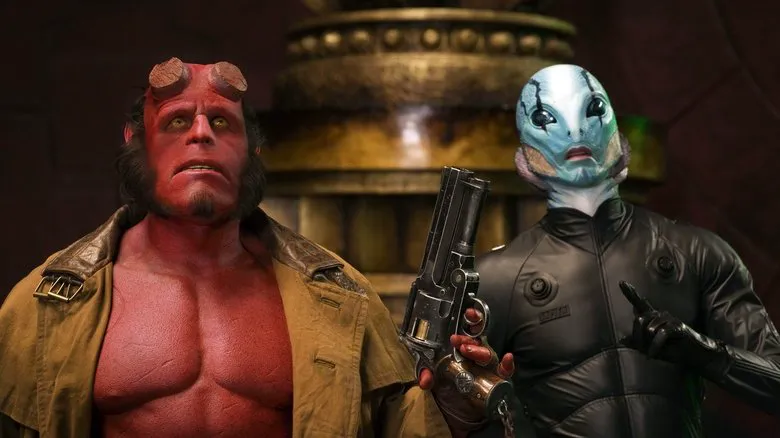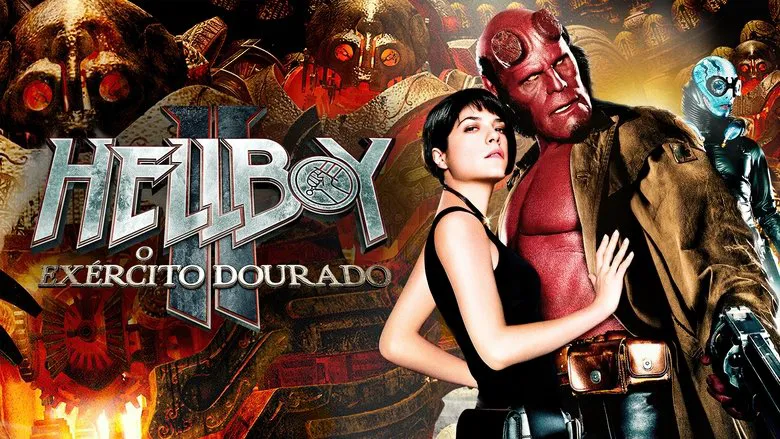Hellboy II: The Golden Army - A Spectacle of Imagination

Hellboy, affectionately known as Red, is a man of imposing stature, a demonic lineage, filed-down horns, and a crimson complexion. He’s employed by a special bureau dedicated to paranormal phenomena. He shares his life with the fiery Liz, his girlfriend, and finds camaraderie with Abe Sapien, the amphibious empath. Together, they must confront a sinister, pale prince intent on resurrecting the legendary and invincible Golden Army. To aid Red and his team, they’re assigned a European agent, a meticulous individual encased in a diving suit, shrouded in a whitish mist, and possessing a distinct German accent. Red harbors some animosity towards the German, perhaps stemming from childhood trauma. Adding to the complexity, Red faces domestic turmoil – because, let’s face it, women can be dramatic.
The original “Hellboy,” Guillermo del Toro’s passion project, has already achieved classic status. The sequel proves to be even more visionary and unrestrained. Ron Perlman, with his infernal charm and unwavering self-assurance, was born to play this role. The only minor flaw is that when you give honest people a substantial budget, they utilize every penny, resulting in a sensory overload. However, criticizing del Toro for “too much” is sacrilegious. His imagination breathes life into characters reminiscent of Goya, Bosch, “Ghostbusters,” and even classic Soviet cartoons (remember that clumsy forest spirit with a leaf on his nose?). This causes viewers to lose all self-control and revel in childlike joy. Del Toro’s bestiary is a work of art in itself; his creatures deserve museum exhibitions, especially when they’re in motion. The audience delights in the fact that “Hellboy II” draws inspiration from various sources but surpasses them all. There are moments of “Harry Potter,” but for adults, larger and redder; hints of Dracula, a vibrant “Star Wars,” a nod to “Frankenstein,” and a greeting to fellow director Peter Jackson – all presented with humor, passion, and ectoplasm.

Del Toro’s Personal Touch
Del Toro and Hellboy are kindred spirits, and it’s tempting to interpret the duology as an autobiography. The director himself arrived in Hollywood from the scorching heat of Mexico, and it’s no coincidence that he personally voiced the infant Hellboy in the first film. In recent years, he’s evolved from a cult eccentric to a mainstream oddity, a local attraction: “That’s our del Toro; he’s a bit mad but harmless. We keep him around because he can infuse big-budget Hollywood with vibrant madness like no other.”
Evolution of Hellboy
While both “Hellboy” films deviate from the comic book source material, the difference between the first and second is striking. Everything has changed. The existential drama has transformed into a romantic comedy (two brilliant scenes are deliberately comedic: when Red and Abe, slightly tipsy, sing along to a pop love song, and when Hellboy is pummeled by a fascist ectoplasm). Even the protagonist has evolved from a devil grappling with philosophical questions about free will into a public figure, a newsmaker who enjoys good cigars and a good fight. The current Hellboy emphasizes his masculine essence rather than his demonic nature; he’s more husband than demon. Even his red tail is used to hold a (still unfamiliar) infant. The question of free will has morphed into “Honey, who do you love more, me or the world?” Liz, who spent the first film worrying about spontaneous combustion, now enjoys it (proving that a married woman’s priorities shift). Liz’s depression now manifests as standard marital squabbles like “I can’t even find a toothbrush in this mess” and “You’re drunk again, you jerk.” Abe falls in love and tries on contact lenses. The word “gothic” is forgotten. Lovecraft has become commonplace and passé.

A Hyperactive Spectacle
The director himself considered the first “Hellboy” a children’s film; well, “Hellboy II” is a film for children with hyperactivity. Everything in the film jumps, flies, and tries to burst through the screen and attack the viewer, cackling menacingly. Del Toro’s monsters, whether it’s a giant green pod that disintegrates in the middle of Manhattan into a mini-Central Park or tiny, savage tooth fairies with shark-like grins, are all remarkable because, in addition to their endless physicality, they don’t confine themselves to their monstrous world but periodically (and with particular glee in “Hellboy II”) glance at the audience. A tasty, nutritious, and plump audience.
The audience ecstatically allows itself to be devoured.